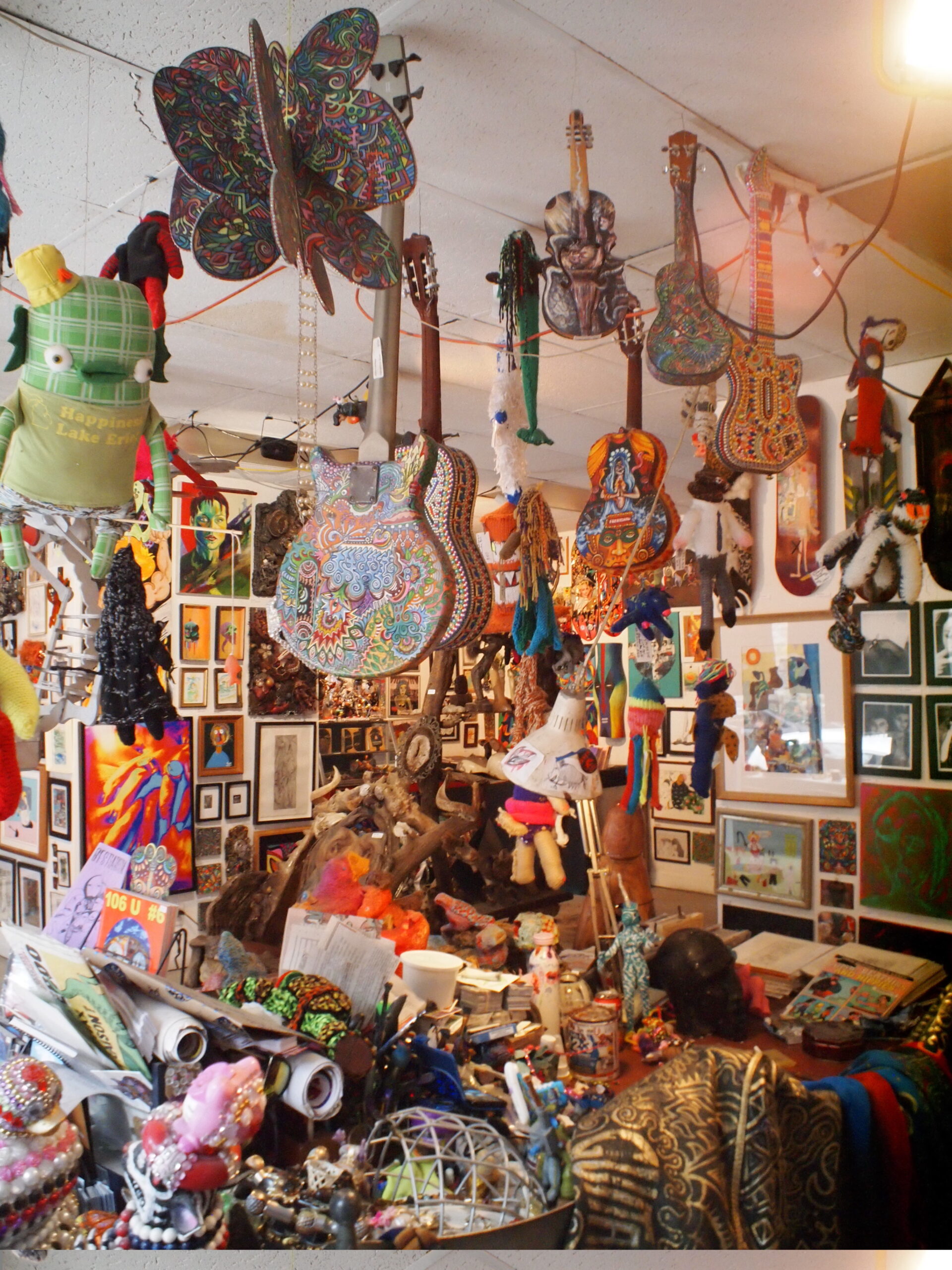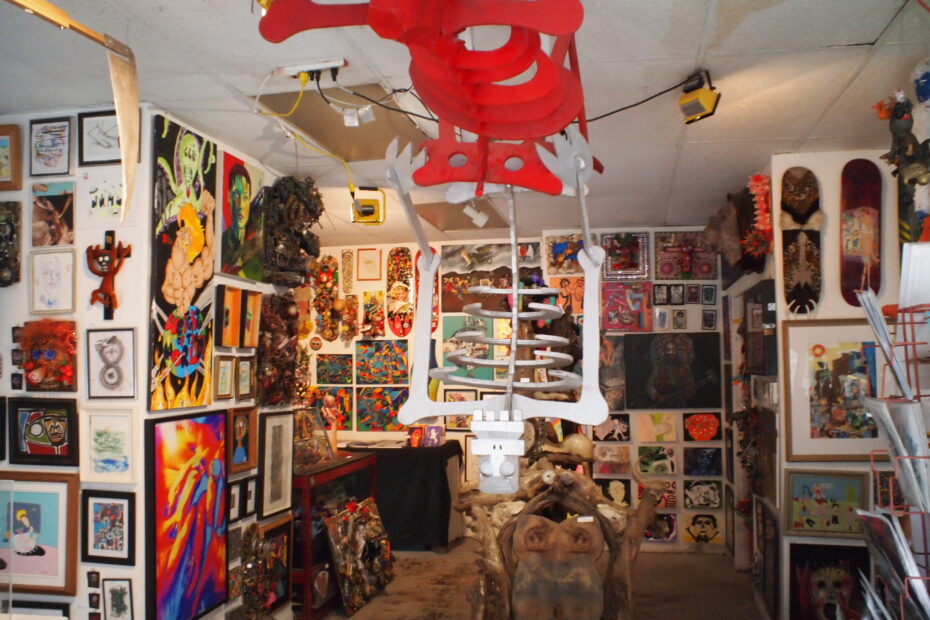Usine 106u is a self-managed art gallery located in the Plateau on Rue Roy E. Founded in 2006 by Eric Braün, Karine Fournier, and Mimi Traillette, the gallery showcases local art from collective and solo exhibitions. Usine 106u aims to break down barriers by accepting submissions from all artists who apply. On March 21, Randa Mohamed sat down with one such artist, John Williams Lanthier — who makes hypnotic sculptures out of found objects, paint, and a variety of mixed media — to discuss his creative process.
Randa Mohamed for The McGill Daily (RM): What is your role at Usine 106u?
John Williams Lanthier (JL): I’m a volunteer here. They call them docents in the museums — people who keep an eye on the art. Docents make sure nobody steals anything, but they also sell things and answer questions. And I help hang the art here. Once a month, we have all the artists dropping off and picking up their art to handle the transfer. And then we put together the jigsaw puzzle of all the different sized paintings. We try to fill all the space on the walls.
RM: Do you guys put up the new art before the Vernissages [an exhibition to showcase new art]?
JL: The Vernissages are on the first Thursday of the month, so we put it up on the first Sunday, I guess, or the Sunday before the Thursday.
RM: How many years have you been part of the Usine?
JL: Six, maybe seven. I guess I first showed up for a month or so, off and on, and then it became more permanent.
RM: How many artists have their work up in here right now?
JL: I think it’s like 35, 40.
RM: Could you describe what a Vernissage is?
JL: Well, it’s an event where people can drink and enjoy the art at leisure and even meet some of the artists and talk to them. And there’s music.
RM: What do you do in your own work? Do you do mainly sculptures these days?
JL: I’ve been working with multimedia assemblages, but I still do some painting. I did a little mural inside the storage closet recently. But many sculptures do include paint.
RM: Did you start out doing sculptures from the beginning?

JL: No, I mean, I was painting for a while, but then I did in art school have a sort of 3D phase and then I went back to super flat and then I got back into the 3D.
RM: Where did you go to art school?
JL: Concordia University. I did painting and drawing as a major and art history as a minor.
RM: Do you think that your work is reflective of themes in your life or that it’s kind of an unrelated outlet?
JL: It’s inspired these days mostly by the objects that I find, which have their own histories. And I just try to combine them in a way that makes sense, that tells a new story.
RM: So you feature a lot of found objects in your art. How do you find them? Do you spend days where you search for things? Or is it more so just as you live your life, you come across things?
JL: Yeah, it’s more like that. I dumpster dive sometimes, but mostly when I pass by and there’s some cool stuff on top of a bin or a box or somebody puts a little sign: “for free”, or something.
RM: This one that you found, [pointing to a cement sculpture of a screaming head painted black] was that found in an abandoned building, you said?
JL: Yeah. I went with some roommates. It was super abandoned. Like total shit. Like all the water covering the floor. Very dangerous.
RM: So these are things which nobody’s going to be looking for anyways.
JL: Yeah.
RM: When you are working on pieces, is there any kind of music that you listen to or any kind of specific mood that you try to get into?
JL: I suppose when I would work on guitars, I would get some custom commissions, so musicians would give me their instruments and they would ask for, a sort of, theme. So, I would pick music that went with that theme. But right now I’m just sort of listening to whatever. Some days, nothing. But, I used to not be able to work without music.
RM: Do you plan things completely before you start making them, or is it just that you kind of start making something and then figure it out as you go?
JL: Exactly. Yeah, that. If you plan too much. It doesn’t leave much room for improvisation.
RM: Yeah. So, the series of sculptures that you worked on with the referees, for example, was it planned that it was going to be a series?
JL: The Beast Battles. No, it wasn’t. I just had a lot of fun with the first one. Then the second, and third. I think I’m at, like, 20 or 21 now.
RM: Could you tell us about those sculptures?
JL: Well, I just make little monsters and then make little environments for them to live in and fight. But I make another little character, the referee, with black and white stripes, and he’s there to make it more sporty, I guess. He’s monitoring it so it doesn’t get out of hand.
RM: Do you think that your work is affected by the different seasons that are happening? In the winter do you find that the work is different from how it is in the summer?
JL: It’s possible because of the found objects. That depends on the season, because people throw out different things. So, in the summer I actually find more Christmas-y stuff because it’s not as much of a hot commodity. So things are not necessarily matching the seasons. I have some Halloween thing that I’ve been working on for a while. I’ve been working on it for maybe a year and a half. Just whenever I find a Halloween-y sort of thing.
RM: Have you been doing art your whole life?
JL: I used to do more crafts when I was a kid. I liked Lego and paper maché, friendship beads, paper dolls, that sort of thing. And then I used to draw comics. Then I got into more realistic portraits, I suppose. And then I got more surreal and then more psychedelic. And now it’s sort of in between pop art, surrealism and psychedelia.
RM: Growing up was there a lot of art going on in your life?
JL: I was a clown. We did a lot of shows. And for maybe six, seven years before that, I was singing and dancing.
RM: Do you have any advice you would give to budding artists?
JL: Make time to do art every day, even if it’s just like, in the metro. And don’t get too focused on the results. It’s the process itself that keeps you engaged with it.
RM: Do you think that doing art can be a form of therapy?
JL: Oh, definitely. It’s helped me a lot to enjoy life, relax.
RM: Has the Usine been a good way to meet other artists and form a sort of community?
JL: Oh, definitely. I’m not that social a person, but yeah, here, I’m forced to engage with the artists who bring their work, and they’re mostly nice people, and I’ve learned a lot from seeing their creations here every month. I try not to steal too much of their style.
RM: Is there something that connects the artwork between all the different artists that are here? Are there some similar themes shared between everyone?
JL: Sort of outsider art, one could say. Not necessarily the minimal or tasteful conceptual art you’ll see in most galleries. It’s more street art, but it’s more of the moment, more real. They are regular people. This is their inner world that they’re sharing with us, whether or not they’re legitimized by the big institutions of art.
RM: Is there a message that you want other people to get from your art?
JL: No, not necessarily. I mean, some of them have a little narrative or whatever, or some sort of color scheme. But no, all these found objects, I guess, have different meanings for different people based on their associations with them. Like if that was like their favorite childhood toy or something.
RM: Do you have a favorite piece that you ever made?
JL: I have a collage that’s covering my apartment, all the ceiling. That’s probably the biggest thing I ever made. I spent a long time on that. It’s very 3D. It’s mostly black and white — all fractals and tracing paper and a lot of movement. A spiral cosmos. We called it entropia or chaosmosis.
RM: Entropia. What does entropia mean?
JL: I made that up in school with two other classmates. It’s from entropy, utopia, or dystopia. And then chaosmosis, another word, is like osmosis, but chaos.
RM: Do you often work at home?
JL: I can do the pipe cleaner stuff there. I just need glue. And it’s not that messy. I can do it on the couch, watching a movie, or something. For almost ten days, I think, I didn’t have a phone since mine cracked. So yeah, I’d be just pipe cleaner-ing — sometimes while waiting for the metro.
RM: So you bring it with you everywhere?
JL: Well, yeah, I always have something to do when I’m out to keep from getting bored.
RM: Do you usually like to keep your hands busy?
JL: An idle mind is the devil’s workshop.
If you’d like to keep up with John Williams Lanthier’s upcoming projects, you can follow him on his Facebook page, John Lanthier Art. Are you an aspiring artist in Montreal? Would you like to see your art displayed in a gallery? You can contact submit photos of your work to usine106u@gmail.com. For more information, visit Usine 106u’s official website.
